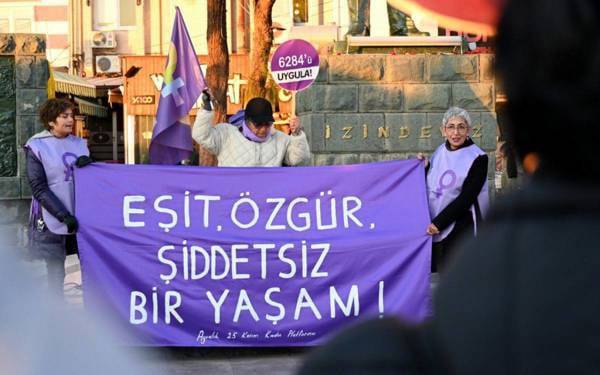Click to read the article in Turkish
"Where are you now?"
"Who are there with you?"
"Send me your location, will you?"
"You will pick up the phone when I call you."
"I am following you with the app that I downloaded to your phone."
"Keep your PC open all the time so that I can see you..."
These sentences frequently said by men to women can sometimes turn into digital violence. While this attitude is usually regarded as "something innocent" or "something that happens in every relationship," it actually harbors a hidden digital violence and, as in the case of dating abuse, women can sometimes be unaware of this type of violence.
On the one side, technological developments make life easier for us; on the other side, they are actively used by men to inflict digital violence on women. To make things worse, digital violence can happen anytime and anywhere.
Offense of digital violence not defined in the law
Digital violence is most frequently inflicted by phones or on social media platforms. Men are harassing women on social media, they are threatening them with death and sexual assault.
From a legal perspective, the offense of digital violence is not clearly defined. For instance, as a result of this "legal loophole," the man who carried out a sexist attack on Başak Demirtaş, the wife of imprisoned politician Selahattin Demirtaş, can be released one day later.
Similarly, a prosecutor's office can give a decision of non-prosecution for the messages threatening main opposition CHP İstanbul Chair Canan Kaftancıoğlu, actress Berna Laçin, journalist Nevşin Mengü and lawyer Feyza Altun with sexual assault.
'It takes on a further dimension every year'
Melike Keleş from the Purple Roof .jpg) Women's Shelter Foundation says that digital violence has increased in the last 15 years. On top of that, women are faced with different forms of digital violence every year. Keleş explains it with an example:
Women's Shelter Foundation says that digital violence has increased in the last 15 years. On top of that, women are faced with different forms of digital violence every year. Keleş explains it with an example:
"Waiting in the line at a tax office, a woman tells the official her mobile phone number. The man standing just behind her hears it and starts harassing her."
Keleş also says, "Those who are subjected to this kind of violence do not apply to us because they do not know. They only apply when digital violence turns into sexual harassment."
'Women threatened with pictures and videos'
According to Keleş, young and single women are faced with digital violence more frequently. She gives the following examples:
"For instance, with or without the consent of the woman, erotic pictures are taken while the couple is still in a relationship, sexual intercourses are recorded. When the relationship ends, men want to use these images and videos to threaten the women.
"A woman applied to us the other day. After having a relationship for a long time, she decided to break up. But the man wanted to use these images and videos to threaten her. Our friend was deeply desperate. He was threatening her with sending them to her family and company.
"Similarly, another woman blocked a man with whom she had a relationship for a short time, but she broke up because she saw tendencies of violence. When the man could not reach her, he joined a live stream of hers and harassed her with his comments."
'I cannot complain, but what else can I do?'
Keleş reminds the women of their rights:
"Women have several rights. However, it is not always that easy for women to use these rights. Because they are threatened and afraid.
"Because they are really afraid. Men threaten them with uploading the images and videos to porn sites. This threat takes on such a dimension that women are forced to tolerate rape by men because of these sexually explicit pictures. They want to make women afraid.
"The most important thing here is that women really shy away from filing a complaint. They come to us and say, 'I cannot file a criminal complaint, but what else can I do?'. They are trying to find alternatives to protect themselves. They really feel cornered."
'They should be penalized on the upper limit'
 Lawyer Tuba Torun from the Feminicides Platform says that digital violence should not be shrugged off as "troll violence." She notes that the crimes committed on digital platforms need to be penalized.
Lawyer Tuba Torun from the Feminicides Platform says that digital violence should not be shrugged off as "troll violence." She notes that the crimes committed on digital platforms need to be penalized.
"Digital violence is not defined in the law, but we want it to be defined. Because it is only when the perpetrators can be penalized," she says.
"A legal action is taken as per the Turkish Penal Code (TCK), treating digital violence as a digital form of the offenses defined in the TCK. However, we insist that digital violence be defined, passed into law and recognized as an offense."
So, let's say that a woman is disturbed by a message sent to her phone constantly. This message does not have to be erotic. As it is insistent harassment and disturbance, it still falls within the scope of digital violence. Lawyer Torun stresses that when a woman applies to the prosecutor's office to complain about such an incident, the prosecutor is to file an indictment.
Torun also underlines that it is possible to penalize digital violence within the frame of existing laws and refers to the Law no. 6284 on the Protection of Family and Prevention of Violence against Women:
"With a restraining order, a man can be restricted from coming into any type of contact with the woman, not only physically."
'Impunity leads to increasing digital violence'
When we remind her that the man who carried out a sexist attack on Başak Demirtaş was released one day later and a decision of non-prosecution has just been given for the perpetrator who threatened four prominent women with sexual assault, Torun emphasizes the following:
"They are, again, targeting the women on social media with political motives. Those who carry out attacks on social media by using women inflict digital violence. They should be penalized on the upper limit.
"The decision of non-prosecution given for the perpetrator of the attack against Canan Kaftancıoğlu and Nevşin Mengü means that violence against women is met with impunity. It is a decision that spreads the perception of impunity. Based on this decision, we can say that digital violence is supported by the hand of judiciary."
Solution: Networks of struggle
According to Torun, the best way to struggle against digital violence is the networks of struggle to be formed by women's organizations and political parties. Concluding her remarks, she also refers to İstanbul Convention:
"This convention also defines digital violence as a crime and indicates that it shall be penalized. If the crime is committed on a digital platform, then, a measure needs to be taken there about it." (EMK/SD)










-13.jpg)
cdvd.jpg)




